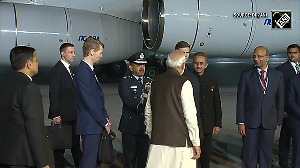Faced with one setback after another in expanding the scope of mining in the country, almost all the major miners of the world have wound down their operations in India.

Having found a massive lithium reserve, the government has a fresh problem.
Who will mine the reserves?
At one level, the answer appears straightforward.
India allows 100 per cent foreign investment in the mining sector, so it should be possible for an Indian company to tie up with a foreign company or the latter going solo to mine it.
But this exercise is more difficult than it appears even after an expected tweak in the mining law.
Faced with one setback after another in expanding the scope of mining in the country, almost all the major miners of the world have wound down their operations in India.
Except Vedanta, which, too, is mired in more than one controversy.
The others have representative offices but no mining operations.
Rio Tinto, for instance, which had discovered large diamond nodes in Madhya Pradesh, had to withdraw due to strident opposition from civil society.
The objection was that the mining, even if underground, will destroy large tracts of forest land.
Last month, the Geological Survey of India announced it has established the presence of 'lithium inferred resources' for a massive 5.9 million tonnes (MT) in the Reasi district of Jammu and Kashmir.
Of course this is the G3 stage, which means just the establishment of the reserves.
The mining will only begin once the reserves are classified as G1.
Experts reckon that the size of the extractable reserves is often whittled down to a third by then.
Still, this is a huge find. To put it in context, Chile has the world's largest known lithium reserves at 9.3 MT (in 2023).
Next is Australia with 3.8 MT, Argentina a little less at 2.7 MT and China has 2 MT.
The total global reserves are estimated at 26 MT; if India adds even 2 MT to this highly prized element, which powers the entire world's electronics, the impact will be huge.
There are enough people cheering the news.
Principal Scientific Advisor to the Government of India Ajay K Sood commended government research body CSIR's efforts to market lithium-ion and sodium-ion batteries.
On the same lines, Pratik Kamdar, co-founder, Neuron Energy, which makes these batteries for e-bikes and e-rickshaws, saw a lot of promise in the news.
'The discovery of this indigenous supply of lithium reserves will help the EV ecosystem reach the masses at reasonable and affordable costs. This will also support the government's vision of EV mass adoption by 2030.'
But the problem still remains: Who will mine these reserves?
A high-level government source said they would expect the private sector mining companies to explore the deposits.
"They keep telling us how effective they are, so it is time they stepped up to the plate," the official said.
The government will need to amend a schedule in the Mines and Minerals (Development and Regulation) Act.
While lithium reserves are usually in deep-seated rocks unlike minerals such as coal, iron ore or even bauxite that yields aluminium, the technology to extract the former is not difficult.
Often, large multinational companies use the expertise of Latin American companies that mine many of these critical minerals including copper as technology support.
India is a late entrant to the field of mining these metals.
For the first time, the National Mineral Exploration Policy of 2016 recognised the need to explore these minerals.
The document noted that the government-run MECL, which is supposed to carry out detailed exploration, has not been up to the task.
'The promotional work done by MECL is negligible,' it notes.
Yet the discovery of mineral exploration programmes for base metals, noble metals, diamond, rare earth and platinum group minerals are 'vital for national security given the requisite priority'.
So, who will mine all these vital minerals and metals?
The procedure is for the GSI to hand over the reports to the respective state governments.
For instance, this time, data sets for 52 mineral blocks containing not only lithium but also gold, potash, molybdenum and base metals spread across 11 states were handed to the states.
This is because mineral mining leases are administered by the respective states, except atomic minerals.
In the case of coal, the auctions are conducted by the Centre, but are then handed over to the states. But this is hardly an optimum approach.
For years, Jharkhand, blessed with an abundant store of minerals, has not had an auction for its mines.
J&K's department of geology and mining has been sort of headless for a long time.
The department accustomed to handling only sand, stone, gypsum and marbles (according to its Web site), now has to draft lithium mining rules involving potentially multi-billion dollars of investment.
Adding to the challenges, there are no Indian companies in the private sector other than oil and gas, with the scale to run such an operation.
The company will also have to scour the money from abroad keeping in mind that the source cannot be from China on geostrategic considerations.
At the Centre, too, the policy environment for mining critical minerals is scarcely better.
The National Mineral Development Corporation is under the Ministry of Steel.
The mines ministry only has the puny MECL (total revenue Rs 237.6 crore as of March 2022) to develop deposits.
A government press release from July 2022 notes that it was instead the 'Atomic Minerals Directorate for Exploration and Research (AMD), a constituent unit of the Department of Atomic Energy that was carrying out exploration for lithium in the potential geological domains of the country'.
A three-company venture under the mines ministry, Khanij Bidesh India Ltd. (KABIL) -- involving National Aluminium Company Ltd, Hindustan Copper Ltd and Mineral Exploration Company Ltd -- has only gone to the stage of signing a non-binding memorandum of understanding with three state-run organisations of Argentina, 'for the purpose of information sharing about prospective mineral acreages of lithium'.
GSI, under the ministry of mines, suddenly appeared in the fray with its discovery.
This is possibly the opportunity for India to develop a ministry of minerals, combining the ministries of mines, coal and steel.
Since Independence, realising the significance of steel and therefore of iron ore for the nation, there has been a steel ministry.
Since the private sector steel companies -- Tata Steel, JSW et al -- have become massive and government-run SAIL does not need hand-holding, it may be wise to wind down the ministry of steel and merge it with a larger minerals ministry.
The budgets of all these ministries are meagre at less than Rs 2,200 crore (Rs 22 billion).
A minerals ministry, like the ministry of natural resources in China, can reverse the conditions.
India imports both copper and aluminium in large quantities despite having abundant reserves of both.
An integrated ministry with its realm in setting up policies that make India's push for critical minerals smarter is what the country needs badly.

Feature Presentation: Ashish Narsale/Rediff.com











